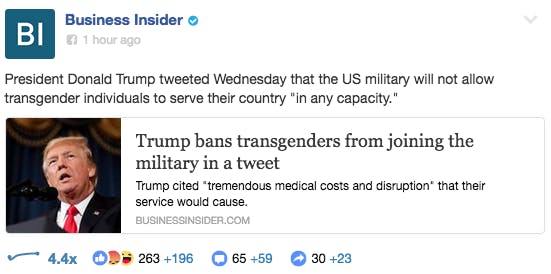Opinion
I’m not allowed to serve in the military anymore. According to President Donald Trump, transgender service members are effectively banned from the armed forces. Adding insult to injury, Trump also described my community in one of the most inappropriate ways possible. He used “transgender” as a noun.
….victory and cannot be burdened with the tremendous medical costs and disruption that transgender in the military would entail. Thank you
— Donald J. Trump (@realDonaldTrump) July 26, 2017
The president isn’t the first person to do this. Shortly after Trump’s tweets hit the news cycle, a slew of writers and public figures began using incorrect terminology to announce the news. Paste used the term “transgenders” in its headline. Military.com called trans people “transgendered,” and so did well-meaning Sen. Tammy Duckworth in a pro-trans interview with Anderson Cooper. Business Insider announced the news with a Facebook headline that read, “Trump bans transgenders from joining the military in a tweet.”
On some level, it’s understandable that reporters and politicians would have a hard time writing and speaking about the trans community properly. Words go in and out of style. Trans issues have only garnered mainstream attention in the past few years. But part of being a responsible journalist and policy maker, as well as a considerate citizen, is keeping up with the modern lexicon. Anything less is unfair to the trans community and signals to others that using outdated terms is OK.
Describing us as “transgenders” or “a transgender” feels dehumanizing. It makes us feel like an object. It’s inappropriate for a professional, established website or entity to talk about trans people that way.
So to break things down, here’s what you need to know to make sure you write and speak about transgender people with the respect and dignity they deserve.
Use the terms “trans” or “transgender” as adjectives, not nouns

“Transgender should always be used as an adjective,” GLAAD writes in its media reference guide. A transgender person should never be referred to as a noun like “transgender,” and the trans community should never be called “the transgenders.” Instead, identify transgender people by using the word “transgender” as a descriptor.
Therefore, “She is a transgender woman” is appropriate. So is “He is a transgender man.” For describing trans people in their entirety, use the terms “transgender people” or “transgender individuals.” And when talking about the wider community formed around trans people, call this “the transgender community.” Otherwise, calling us “transgenders” makes us sound like another species.
“Trans” is also an acceptable shorthand replacement for the full term “transgender.” But it may be clearer to begin a piece of writing by using “transgender” so readers understand that “trans” is an abbreviated form of the full word.
Stick to preferred pronouns and names

A couple years back, I wrote a student column on trigger warnings that was picked up and subsequently mocked by conservative pundits. Since then, a couple of books have referenced the article. But most writers don’t put in the time and energy to research my gender transitioning, so they end up using my dead name whenever they reference me in books, papers, and articles. It hurts pretty badly, but going out of my way to correct them would expose the world to my old name.
When a trans person’s given name is used in an article, it feels like a slap in the face—the same goes if you are talking to or about a trans person in real life. Always use a transgender person’s chosen name and pronouns when referring to them. Using a transgender person’s old, given name is called “deadnaming,” and it’s considered highly offensive. This is because doing so references a part of a transgender person’s life that never truly described who they were in the first place. Conversely, using a transgender person’s chosen name is affirming.
For instance, when referring to Caitlyn Jenner, never refer to her as “Bruce Jenner.” Always call her Caitlyn Jenner, and use she/her pronouns.
Of course, there are some exceptions to this rule. The National Center for Transgender Equality cites the New York Times Style Book on this, arguing that deadnames can be mentioned when “newsworthy or pertinent.” For instance, when writing about the 1976 Olympic Games, it is newsworthy to point out that Caitlyn Jenner transitioned and was previously referred to as Bruce Jenner. But it is neither newsworthy nor pertinent to ask a transgender woman on the street what her deadname was unless she purposefully goes out of her way to talk about her given name at birth.
Keep up with contemporary terminology

In the early 20th century, “transvestite” was a much more common term that transgender people used to talk about trans individuals. Magnus Hirschfeld originally created the term in 1910, and he stressed at the time that there was a difference between transgender individuals and crossdressing.
Over the years, that distinction blended together, to the point where “transvestite” is often interchangeable with “crossdresser.” Today, “transvestite” is largely confined to the dustbin of history for the trans community. In other words, it’s a highly inappropriate term to describe trans people. I would never use “transvestite” to describe myself, nor would I use it as a journalist to describe a trans person.
https://twitter.com/ShortSlytherin/status/890273770140729345
https://twitter.com/RealDorianDawes/status/876355776469749761
“Transgendered” has similarly become outdated over the past couple decades. As writer Helen Boyd points out, “transgendered” was purposefully used back in the ’70s and ’80s to imply that a person had transitioned. It was like using the word “queering”; as the logic went, trans people were “transgendering” gender. Over time, the -ed and -ing suffix were simply dropped, and the term became outdated. Today, it’s considered highly inappropriate and best left avoided.
Meanwhile, “transsexual” has undergone a similar problem. While some trans people still use the term in reference to themselves, many of us prefer not to call ourselves transsexuals because it implies our gender and sex are linked together. Which is most certainly not the case. For that reason, unless a person self-identifies as a transsexual, it’s better to refer to the transgender community as “transgender” or “trans.”
GLAAD’s media reference guide provides important information on trans terminology, its origins, and whether a word is contemporary or outdated. While it’s intended for journalists, it’s also an excellent source for anyone with questions about which words are affirming or discriminatory.
Avoid phrases like “born a man” or “born a woman”
When I first started working as a news reporter, I wrote an investigative piece in which I interviewed a transgender woman. During the editing process, my editor proceeded to add in that the transgender source I interviewed was “born a man.” He was afraid cisgender readers wouldn’t understand that she transitioned genders, so he wanted to add in the phrase to clarify. In reality, saying that my source “was born a man” was terribly offensive to my interviewee, and the edit nearly ruined my credibility as a writer.
For journalists, public figures, and the world at large, it’s important to describe trans people with the utmost respect. Using phrases like “born a man” or “born a woman” invalidates a transgender person’s gender identity. GLAAD calls this a “reductive” phrase and instead encourages talking about gender transitioning in a more sensitive light.
“People are born babies and a doctor decides the sex based on a quick look at the baby’s external anatomy,” GLAAD states. “A transgender person’s gender is much more complicated than a simple glance at external anatomy can capture.”
If you need to explain transgender topics to a reader, GLAAD says that writers should use terms such as “assigned male at birth” or “designated female at birth.” For example, if a journalist interviews me and wants to talk about my gender transitioning, they should write, “Ana Valens is a transgender woman. She was assigned male at birth, and later transitioned while in college.” It would be highly offensive for a journalist to say, “Ana Valens was born a man,” because I was never a man—I was just assigned a sex and gender at birth.
Avoid honing in on physical features that will ‘clock’ a trans person

When I was in college, our student newspaper brought me on as a sensitivity reader for an interview feature on a transgender student. My job was to read through the writer’s draft and make sure their description of the interviewee was respectful and affirming. Simple enough.
But the writer opened the story by describing her interviewee’s Adam’s apple on her neck. It was a highly transphobic description of the student because the writer was trying to gender the trans student’s physical features as masculine. I told editorial to take out the phrase.
This happens frequently in long-form stories that focus on a transgender subject. Writers latch onto physical characteristics that “clock” the subject as transgender: height, physical features, body shape, beard shadow (or lack thereof), just to name a few. It’s pretty offensive and aims to recenter the piece on the sex the person was at birth, not on the person they identify as.
For the uninitiated, when a transgender person is “clocked,” that means they are seen as transgender by bystanders. The Advocate says the word is used “to reflect that someone transgender has been recognized as trans, usually when that person is trying to blend in with cisgender people, and not intending to be seen as anything other than the gender they present.”
When someone points out a transgender person’s “clockable” features it suggests that every transgender person is noticeably transgender. That just isn’t true. It also suggests that trans people can and should be identified for physical aspects that mark them as trans, in order to reveal a transgender person’s assigned gender at birth. In other words, it implies that trans people are deceptive people hiding something from the world.
Not only is this transphobic, it also doesn’t make sense. In reality, every person has some androgynous features, which means anyone could be seen as transgender if a strong enough argument is made.
Don’t obsess over a trans person’s gender transitioning

There are some stories where a person’s gender transitioning is highly relevant. Chelsea Manning, for instance, is a trans woman who transitioned while in prison. Her gender transitioning is an important part of her life story and her role in the public eye. She works as a trans activist and fights openly for transgender rights. Plus, she’s pretty open about her gender transitioning in military prison.
This is not the case for every transgender person. Gender transitioning is a highly personal and highly sensitive subject. When in doubt, unless a transgender person is specifically open to talking about their gender transitioning, a journalist shouldn’t bring it up during an interview, nor should any person do so when they meet a trans person. And if gender transitioning does come up, remember not to focus too heavily on the role that surgery plays in transgender peoples’ lives. Many trans people simply refrain from going under the knife, either due to financial issues or a lack of interest.
“Not all transgender people choose to, or can afford to, undergo medical surgeries,” GLAAD explains. “Journalists should avoid overemphasizing the role of surgeries in the transition process.”
Writing and speaking about transgender issues can be tough. But trans rights are becoming a modern civil rights issue, covered daily by outlets like the New York Times or the Washington Post. For journalists and policy makers, accuracy means using the right terminology. Otherwise, it can set a harmful precedent.
So when in doubt, do your research. Double check, then check again. It could save your credibility—and a targeted community a lot of heartache.

